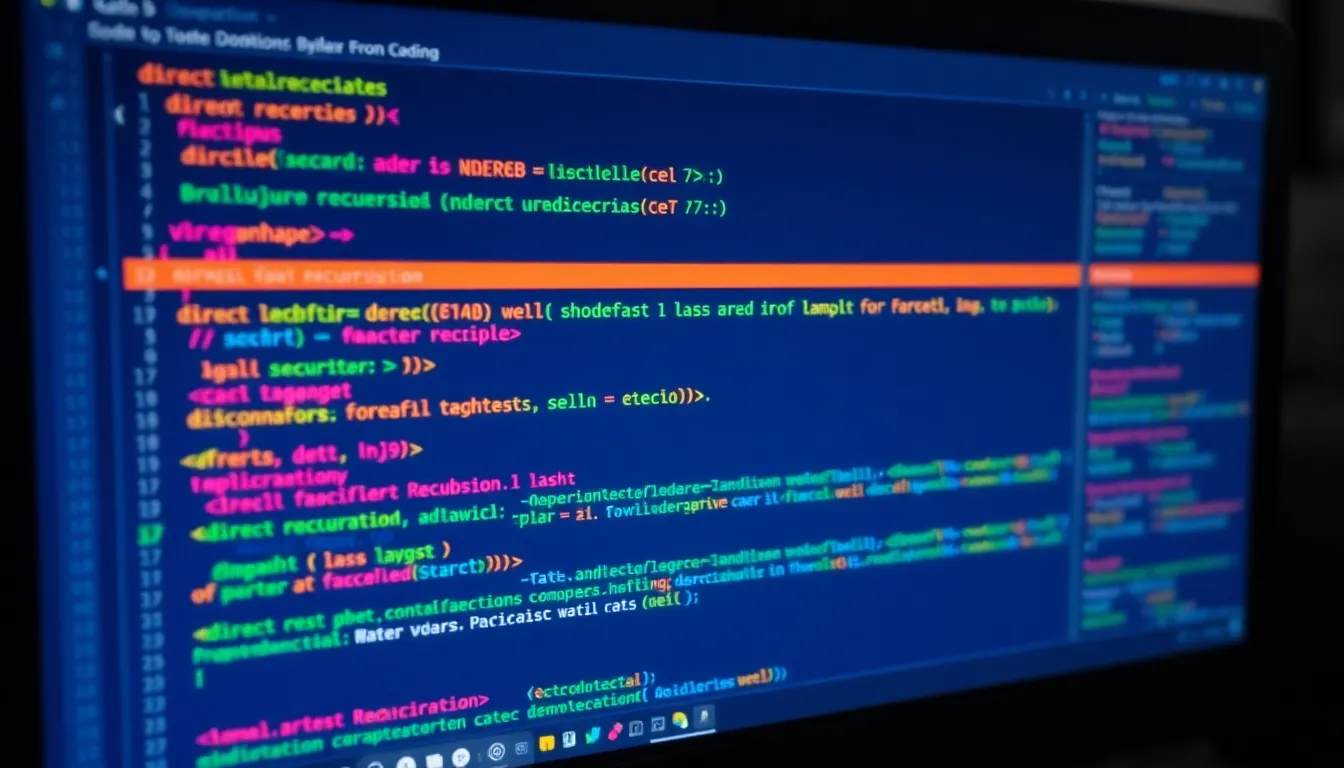Ever stared into the abyss of a coding problem and thought, “Why not just call myself again?” Welcome to the wacky world of recursion, where functions get a little too cozy with themselves. It’s like that friend who can’t stop talking about their favorite movie—just when you think they’re done, they start over with a new twist.
Table of Contents
ToggleUnderstanding Recursion In Coding
Recursion forms an essential concept in programming. This technique enables functions to call themselves, creating elegant solutions to complex problems.
Definition Of Recursion
Recursion refers to the process where a function calls itself. It simplifies problems by breaking them down into smaller, more manageable subproblems. Each call to the function typically involves a base case that stops the recursion, ensuring the function doesn’t run indefinitely. For example, calculating the factorial of a number showcases recursion effectively. When calculating 5!, the function computes 5 times 4!, continuing until it reaches the base case of 1.
The Importance Of Recursion
Recursion plays a critical role in computer science. It provides a powerful tool for solving problems like traversing data structures and implementing algorithms such as quicksort and mergesort. Recursion often leads to cleaner, more readable code compared to iterative solutions. Developers frequently encounter scenarios where recursion simplifies logic and enhances performance. In some cases, recursion eliminates the need for additional data structures, making it both efficient and elegant.
Types Of Recursion

Recursion in coding can be categorized into two primary types: direct recursion and indirect recursion. Understanding these types assists in effectively applying recursion in various programming scenarios.
Direct Recursion
Direct recursion occurs when a function calls itself directly. This method clearly illustrates the self-referential nature of recursion. An example includes calculating Fibonacci numbers, where the function repeatedly invokes itself with smaller arguments until it reaches a base case. Direct recursion can lead to elegant implementations, minimizing code complexity. It’s essential to ensure that base cases are carefully defined to prevent infinite loops. Languages like Python and Java facilitate this recursion type, emphasizing cleaner code through straightforward function calls.
Indirect Recursion
Indirect recursion involves two or more functions calling each other in a cyclical manner. In this scenario, Function A calls Function B, which subsequently calls Function A again. This creates an indirect relationship between the functions. A practical example is found in algorithms that manage the interaction between different components of software. Indirect recursion can introduce complexity, so maintaining clarity in function relationships is crucial. Debugging and tracing execution paths become more challenging, making careful design vital for effective implementation in programming tasks.
How Recursion Works
Recursion operates through a systematic method of self-reference in functions. This method relies on breaking down problems into smaller, easier-to-solve components.
Base Case
A base case serves as the stopping point for recursion, ensuring it doesn’t result in infinite loops. It’s essential to define base cases explicitly to provide clarity. For example, calculating the factorial of zero returns one, establishing a clear endpoint. Without this foundation, recursive functions may loop indefinitely, consuming resources and causing stack overflow. Identifying simple cases makes it easier to build more complex solutions. Establishing a base case promotes efficiency by minimizing unnecessary computations.
Recursive Case
The recursive case encompasses the primary logic of a recursive function, where the function calls itself with modified parameters. This part of recursion provides the mechanism for breaking down the problem. For example, calculating the factorial of a number n involves n multiplied by the factorial of n minus one. Each call reduces the problem’s complexity, bringing it closer to the base case. Understanding how to properly construct the recursive case is vital for effective programming. Efficient design leads to cleaner code and often enhances performance, allowing functions to address complex tasks seamlessly.
Advantages And Disadvantages Of Recursion
Recursion in coding offers distinct advantages and disadvantages that impact its use in programming. Understanding these aspects helps developers make informed decisions when implementing recursive functions.
Advantages
Cleaner code often results from using recursion, making complex tasks easier to read and maintain. Developers find recursive solutions can simplify algorithms, especially in tasks like tree traversals or sorting. Efficiency sometimes increases as recursion eliminates the need for additional data structures, reducing memory usage. Faster execution occurs with optimized algorithms such as quicksort, which leverage recursion. Enhanced problem-solving skills emerge as programmers practice breaking problems into smaller, manageable parts, fostering a deeper understanding of algorithmic thinking.
Disadvantages
Recursion introduces challenges that programmers must consider. One significant drawback includes increased memory consumption due to function call overhead and stack depth. Performance issues may arise, particularly with deep recursion that leads to stack overflow errors. Additionally, debugging recursive functions often proves more complicated than debugging iterative solutions, making it harder to trace logic. Not every problem lends itself well to recursion, and implementing an inappropriate recursive approach can lead to inefficiency and confusion.
Common Use Cases For Recursion
Recursion serves various essential purposes in programming, particularly in algorithms and data structures.
Algorithms
Sorting algorithms often rely on recursion to efficiently handle data. Quicksort and mergesort exemplify recursive algorithms that divide large datasets into smaller subsets for sorting. These algorithms not only optimize sorting but also simplify logic through recursive structure. Searching algorithms utilize recursion as well. Depth-first search (DFS) for trees and graphs exemplifies this, allowing programmers to explore nodes and paths more intuitively. Thus, recursion turns complex algorithms into manageable pieces, resulting in efficient problem-solving.
Data Structures
Data structures frequently benefit from recursion, especially when traversing hierarchical structures. Binary trees serve as a prime example of recursive data structures. Functions that perform operations like searching or inserting elements call themselves until reaching a leaf node. Recursive traversal simplifies the process, enabling clearer code for functions like preorder, inorder, and postorder traversals. Linked lists are another example where recursion shines. Adding or removing nodes involves calling the same function on the next element until the operation is complete. Consequently, recursion enhances efficiency and code readability in various data structure operations.
Recursion is a powerful tool in programming that can simplify complex problems and enhance code readability. By breaking tasks into smaller components it allows for elegant solutions that are often easier to maintain. However it’s crucial to use recursion judiciously as improper implementation can lead to performance issues and debugging challenges. Understanding both direct and indirect recursion equips developers with the skills to tackle a variety of coding tasks effectively. Embracing recursion can foster improved problem-solving abilities and contribute to more efficient algorithms in software development. As with any technique in coding it’s essential to weigh the benefits against potential drawbacks to determine the best approach for each unique challenge.










